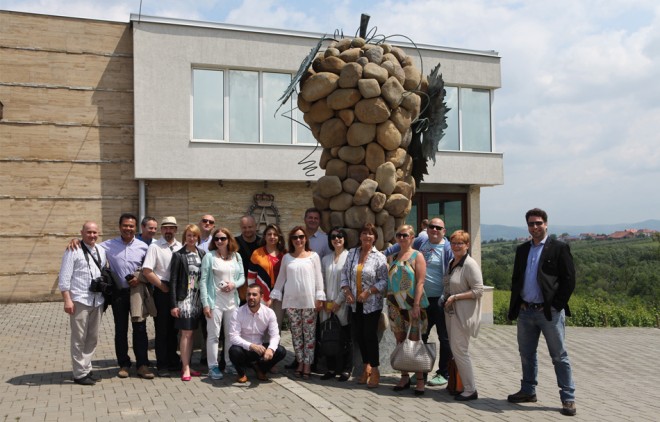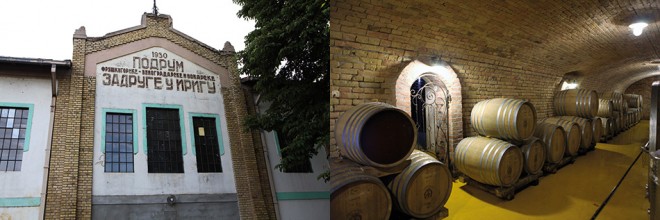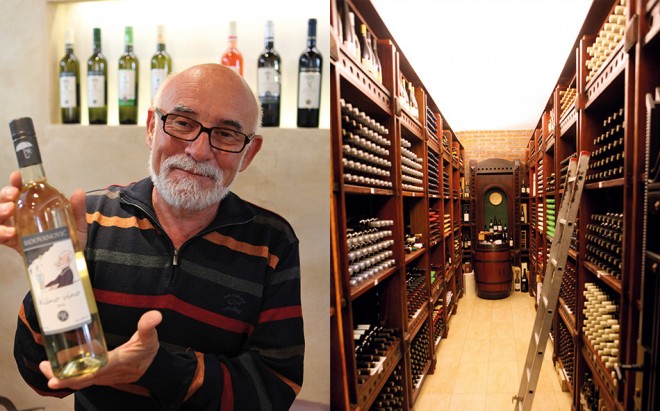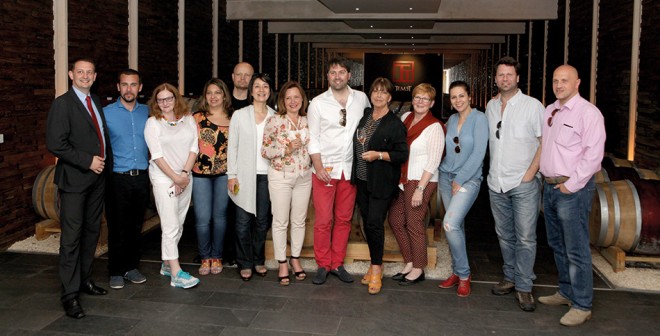In a parallel to the assembly organized in Belgrade in early June 2016 the delegates of Association de la Sommellerie Internationale (A.S.I.) visited some domains led by Dejan Zivkoski and Durda Katic. They could see that Serbia, a country with a wine making tradition, offers a wide range of terroirs and grape varieties. Now Prokupac, Vranac or Tamjanika are no longer a secret to them.

For many of the sommeliers present, this iniatory journey started in Palic, North of Belgrade near the border with Hungary. On the lands of the Zvonko Bogdan winery, they discovered a place perfectly equipped for wine tourism. Welcomed by the owner Andor Cakanj in a kind of castle that stands at the heart of the vineyard; their visit led them to the barrel cellar. A place that evidences in itself the investments made.
Two ranges of wines have been proposed for tasting. The range “Classique” comprises the three colours in the form of blend wines. The collection “Premium” consists of four white varietal wines: Sauvignon Blanc, Pinot Blanc, Pinot Gris and Chardonnay. A dry rosé confirms the success of such wines. At last “Cuvée No. 1” is a red blend stemming from a hand-picked crop of selected vine stocks. In terms of image, Zvonko Bogdan is very advanced. First with its name that is in fact the name of a well-known Serbian singer who sponsors in a way this ‘vinarija’. The labels of the Premium range also are original as they are signed by painter Eugen III Kocis.
Still North of Belgrade but in Novi Sad, the second city of Serbia, the A.S.I. members appreciated the more rolling landscapes, and above all they could approach the history of the Serbian viticulture. Bearing the marks of decades of activity, a 1930 cooperative building shelters the ageing cellar of the Kovacevic winery. A family of wine growers represented by Miroslav, member of the third generation who fitted out the technical part, especially the vathouse, in an adjacent building. From a sparkling made of 85% Chardonnay and 15% Rhine Riesling to the most prestigious cuvees “Chardonnay Barrique” and “Aurelius”, the delegates could appreciate the character of the wines of this region.

South of the Serbian capital city, history was there again. At Topola the visit of St George’s Church with its 3,500 sq.m. of Murano glass mosaics, then of Peter I of Serbia’s hunting lodge met big success. As much as the visit of the Pik Oplenac winery to the sound of traditional songs. An estate who is celebrating its 60th anniversary although it has been privatized only in 2014. It has to be said that the events that occurred in the second half of the 1990s left marks on the wine making activity. Only did time and new investments result in a successful relaunch that is now visible through the presence of extremely fine wines such as “100% Muscat Otonel” or the Cabernet Sauvignon-based cuvee “Tron”.
It is thus clear that to find their place on the 21st-century wine marketplace the Serbian estates cannot submit to the events. They draw a new energy from the development of a real wine touristic policy. The sense of welcoming and highlighting the viticultural heritage can be felt as from the entrance of the Aleksandrovic winery where the sculpture of a huge bunch of grapes is a waypoint just outside Topola. The estate runs 75 hectares of vines. “The vineyards are grouped in three places that are characterized by different microclimates and soil types. These locations are used for vine growing since ancient times. Using our own experience we strategically planted different grape varieties there where they can achieve the best results. At Vinca, close to the winery, we have planted Sauvignon Blanc. On the hill of Ježevac there is Cabernet Sauvignon, Merlot, Muscat Hamburg and Chardonnay. At last on the hill of Bokanja where King Alexander I planned to establish his own vineyards, we planted Pinot Noir, Rhine Riesling and Sauvignon Blanc.”
All that is necessary to make a broad range comprising “Trijumf gold” (a blend of Sauvignon Blanc, Rhine Riesling and Pinot Blanc) and “Trijumf noir” (100% Pinot Noir) that are especially attractive.
Attractive, Mija Radovanovic also is. His estate Podrum Radovanovic is located at Krnjevo and he is considered to be the Cabernet Sauvignon specialist in Serbia. The 30-hectare vineyard benefits from a rolling landscape and the best exposures.
Trained enologist he first built up his experience in the state viticulture before setting up his own estate in the early 1990s. Convinced that the character of each wine is the fruit of a huge diversity, result of the climate and the geology, the man with a penetrating gaze pays a good deal of attention to preserving the specificities of each of them.
He thus made significant investments for the whole production chain to offer a very distinctive expression of the various grape varieties. Under ground the large vinification and ageing cellar leaves pride of place to the oak barrels. They give a kind of signature to the cuvees made by a man who explains his relationship with the wines and the wine: “Wine is an endless story whose plotline is written by us but whose conclusion is exclusively designed by time. I know the quality of my wines is not definitive, it can always improve. Progress is my continuous challenge. Thus my story with wine has no end …”
But with the cuvees “Classique” and “Réserve” who both celebrate the personality and finesse of the Cabernet Sauvignon, the man managed to position recognized wines on the international market. And to fully convince his visitors he proposed to highlight them over a dinner.

What the A.S.I. delegates will also remember is Milorad Cilic (domain Cilic)’s personality and talent. Yet nearly 40, he still is a young wine grower who asserted himself in his father Zoran’s steps. A front-line enologist who sat for forty years nonstop on the state commission of wine assessment and shared his knowledge. A savoir-faire that Milorad, member of the eighth generation, successfully cultivated by discovering the wine growing and crafting methods in France, Argentina, Chile and the United States.
He came back very inspired showing a recognized savoir-faire in vinification, alternating varietal wines and blends, and in marketing and hospitality in a structure perfectly designed for the reception of the grapes … and of the visitors. His estate that now totals 20 ha is made from 136 plots of land mainly located around Jagodina. And although he gave priority to Bordeaux grape varieties—he has once been invited to be a jury member at the contest ‘Les Citadelles du Vin’—he shows great interest in Pinot Noir.
A few hundred meters further, also settled among vines at the top of a hill, the last visit aimed at discovering the Temet winery. Finished building in 2013 and wonderful architect work, the winery is not only fitted out to make work as smooth as possible, but also is a wine touristic asset.
Everything has gone fast. Most of the vines have been planted in 2009 and since then, the owner Aleksic Nebojsa stepped up huge efforts to attract the specialists’ attention on the quality of Temet’s wines.
He owes his enthusiasm for wine to a journey in France as a student. And his curiosity leads him to make blends that bring both countries together like his cuvée “Tri Morave Crveno” that combines Prokupac and Merlot, alongside the cuvée “Tri Morave Belo”, a blend of local varieties, Mederevka, Tamjanika and Morava. And at Temet, like anywhere else, they ride the international customers’ craze for rosé. Blending Shiraz and Cabernet Sauvignon, they signs the cuvee simply called “Rose”.
Beyond the charm of the place the delegates could appreciate the visit of the technical part that evidences the huge investments made. The row of stainless steel tanks echoes the French and Serbian oak barrels that give a signature to the yearly production of 100,000 litres exclusively exported.

The A.S.I. delegates also understood that the generosity of the soil, the confluence of the Mediterranean and continental climates, and the entrepreneurial spirit that moves enthusiast investors or heirs inspired by journeys abroad, are as many assets in this part of Europe. But the most difficult for these wine growers is to cross the borders to find new markets. But with such a quality—as the members of A.S.I. could notice—the battle may be quite easy to win.